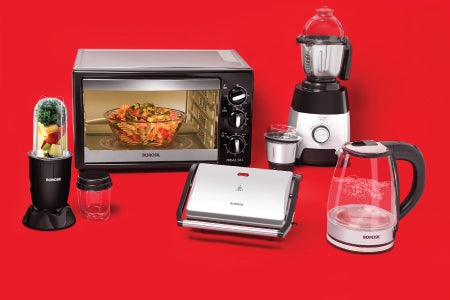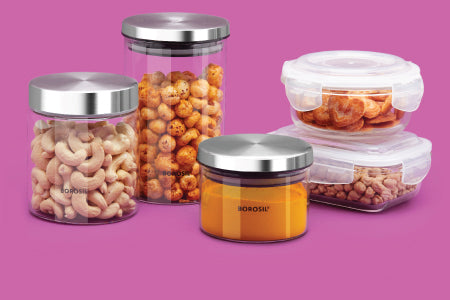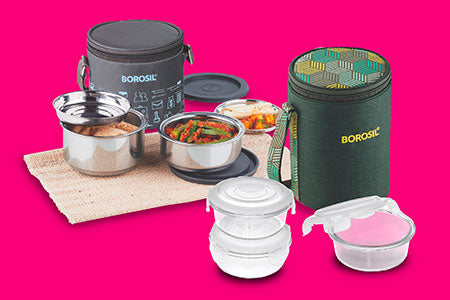
How To Not Treat Your Stainless Steel Cookware
Stainless steel is arguably the most versatile material for kitchen equipment, from pans to utensils to appliances to countertops. Triply stainless steel cookware is a rage nowadays and you can easily find SS cookware deals in the market and SS cookware on sale online. These include stainless steel pressure cooker, stainless steel triply kadai, stainless steel frying pan, stainless steel saucepans, stainless steel milk pan, and the entire stainless steel kitchen set! Owing to their durability, heat retention, and above all being a safer alternative and the best cookware for healthy cooking, people are more inclined to buy the best steel cookware in India over any other material. It's highly corrosion-resistant and virtually heatproof, and also the best cookware set for induction cooking. The best stainless steel cookware in India is just what you need for all your daily cooking requirements.
However, it is not enough to buy the best quality stainless steel cookware in India, but it's also essential to maintain them to get maximum use out of stainless steel kitchenware. While you might know all the DOs required to maintain stainless steel pots and pans, do you know the mistakes that you might unknowingly be making that may ruin this nearly indestructible cookware?
Stainless steel can be damaged by abrasive pads, the wrong kinds of cleaners, and even ordinary things like water and salt.
Here are the top 10 absolute DON'TS while treating your stainless steel cookware -
1. Don't bleach stainless steel - While it may be second nature to bleach everything, stainless steel and chlorine do not mix. Be aware that bleach and chlorides can be included in different types of cleaners. If you accidentally get chlorine on your stainless steel casserole with a glass lid or the stainless steel kadai with a heavy bottom, the steel pots for cooking, or any other cook and serve cookware, rinse it off quickly and thoroughly.
2. Don't use abrasive cleaners - Don’t use steel wool or any kind of abrasive cleaners on your stainless steel frying pan with lid, or your stainless steel induction cookware in general, as it can damage the finish and leave behind little pieces that can pit or damage its surface. Instead use sponges, plastic scrubs or a soft cloth to clean your stainless steel cookware.
3. Don't forget to rinse - Gritty or dirty water can leave a residue on your finish. It can also stain or pit the surface of your stainless steel. Be sure to rinse completely. Similarly, residue from cleaning solutions left on a stainless steel surface can stain or damage the finish. Rinsing is a key component for cleaning stainless steel.
4. Don’t let the pan sit empty on the burner for too long - Let’s be clear: Yes, you want to preheat your SS skillets and frying pans for a bit before sautéing or searing. But don’t let that empty pan preheat for too long, or let it boil dry because the prolonged high heat can cause stubborn discoloration. You might end up with yellow, brown, bluish, or rainbow tints on the surface that are hard to get off. And if that does happen, gently scrub at the stains with vinegar, or cook some acidic food like tomato sauce. The acidity in the tomatoes will help with the discoloration.
Also Read: 6 Effective & easy ways to clean your glass-top gas stove
5. Don’t use it on a grill (or in a microwave) - Even though they are the best cookware to cook food in, most stainless steel pots and pans are meant to be used at moderate heat and technically can withstand up to 500 or 600 degrees Fahrenheit. A grill has the potential to get much hotter, which can damage and warp the metal, and therefore, it is advised to use your SS cookware only on the gas or induction cooktop, unless approved otherwise by the manufacturers.
6. Don’t use cooking sprays - The problem with cooking sprays is that they don’t just contain oil, they also have things like emulsifiers, propellants, and anti-foaming agents. The emulsifiers, in particular, have a tendency to build up into a sticky, cooked-on coating.
7. Don't oil a cold pan - Stainless steel, like other metals, expands when it is heated. Letting the pan heat up before adding oil or other fat results in a more non-stick surface than starting with oil in a cold pan. At the other end of the spectrum, burned-on oil can be very hard to remove from stainless steel.
8. Don't salt water before boiling - Salting the water in a stainless steel pot before heating the water can lead to pitting. These tiny bits of rust on the stainless surface are permanent. Prevention is just as simple: let the water boil before adding salt. Just be careful to add a little bit at a time because adding salt to boiling water can make it boil over.
9. Don’t use a knife to cut something in the pan - Maybe you just want to make a teensy cut to see if the meat is done, or maybe you realized some of your pieces are too big and you want to cut them in half. It’s so tempting to skip the cutting board and just reach for your chef’s knife and do it in the pan. But that’s a big no-no as that’s the worst thing you can do for your pan and your knife. You’re going to leave a permanent mark in the pan.
10. Don’t put a hot pan in a sink of cold water - This just might be one of the most important things to remember. When a super-hot pan is tossed in cold water, the thermal shock can warp the metal. This is especially true if the pan got overheated. Instead, let the pan cool down first and use warm water instead of cold.





















